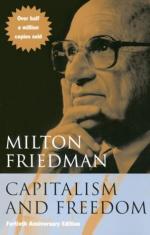
|
| Name: _________________________ | Period: ___________________ |
This test consists of 15 multiple choice questions and 5 short answer questions.
Multiple Choice Questions
1. What has capitalism done for discrimination according to Friedman?
(a) Widened.
(b) Reduced it.
(c) Increased it.
(d) Abolished it.
2. Who said, "There is much ruin in a nation"?
(a) Carl Menger.
(b) John Maynard Keynes.
(c) Milton Friedman.
(d) Adam Smith.
3. What term describes the deliberate setting of prices through an agreement by firms?
(a) Labor unions.
(b) Monopoly.
(c) Collusion.
(d) Free market.
4. What specific social responsibility does Friedman condemn for corporations?
(a) Right to work laws.
(b) Sweat free labor practices.
(c) Charitable giving.
(d) Fair hiring practices.
5. What is the major reason Friedman asserts why government intervention has had the opposite of the intended effects?
(a) People do not abide by the rules of the government.
(b) People attempt to promote their own interests.
(c) A wealthy few have made the majority of the decisions for the minority.
(d) People in power only seek political gains.
6. What type of society does Friedman believe is least materialistic?
(a) Marxist.
(b) Collectivist.
(c) Capitalist.
(d) Socialist.
7. What is one disadvantage Friedman describes of programs to alleviate poverty?
(a) Fraud.
(b) Funding.
(c) Administration.
(d) Authorization.
8. Friedman suggests that employees may prefer to have part of their remuneration take the form of amenities such as what?
(a) Baseball fields.
(b) Parking spaces.
(c) Housing allowance.
(d) Libraries.
9. According to Friedman, what are licenses restrictions on?
(a) What schools professionals may attend.
(b) The qualifications of those doing the hiring.
(c) The age of those who are licensed.
(d) Who may hire whom.
10. Instead of reducing inequality, Friedman states the income tax has favored ______.
(a) The growth of labor unions.
(b) Public housing.
(c) Subsidies for farmers.
(d) The growth of large corporations.
11. Who does Friedman believe is most critical of capitalism?
(a) Democrats.
(b) Socialists.
(c) Marxists.
(d) Communists.
12. What is one method that governments have used to alter the distribution of income?
(a) Social welfare.
(b) Selling bonds.
(c) Real estate law.
(d) Income taxation.
13. How many problems with monopolies does Friedman describe?
(a) Two.
(b) Three.
(c) One.
(d) Four.
14. If forced to choose between segregation or integration, which would Friedman choose?
(a) Neither.
(b) Segregation.
(c) Integration.
(d) A combination.
15. What is one factor that Friedman believes has reduced inequality?
(a) Civil Rights laws.
(b) Government intervention.
(c) Advances in technology.
(d) Educational opportunities.
Short Answer Questions
1. What problem did Dicey write about in 1914?
2. Friedman simply states that to alleviate poverty, we should have a program directed at ______.
3. Labor unions are referred to as ______.
4. In Chapter 12, The Alleviation of Poverty, what two things does Friedman say a person cannot be at the same time?
5. Friedman gives the following examples of the negative effects of government intervention except ______.
|
This section contains 447 words (approx. 2 pages at 300 words per page) |

|




